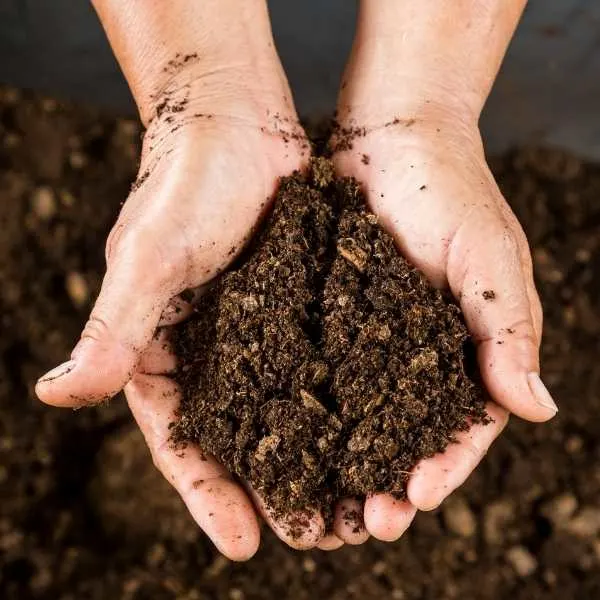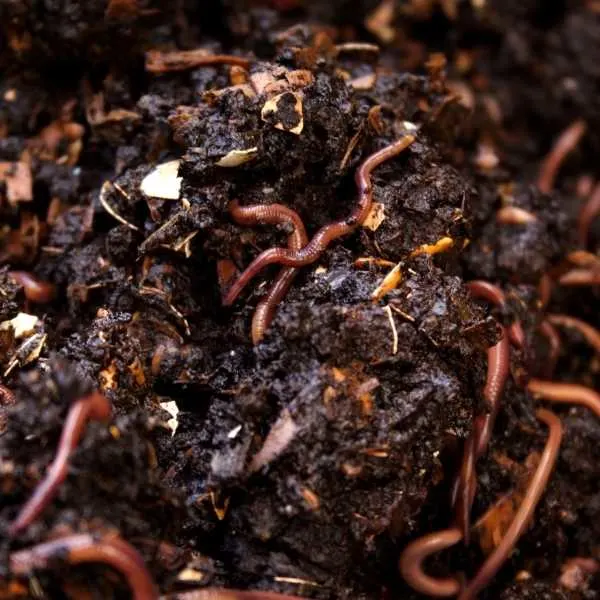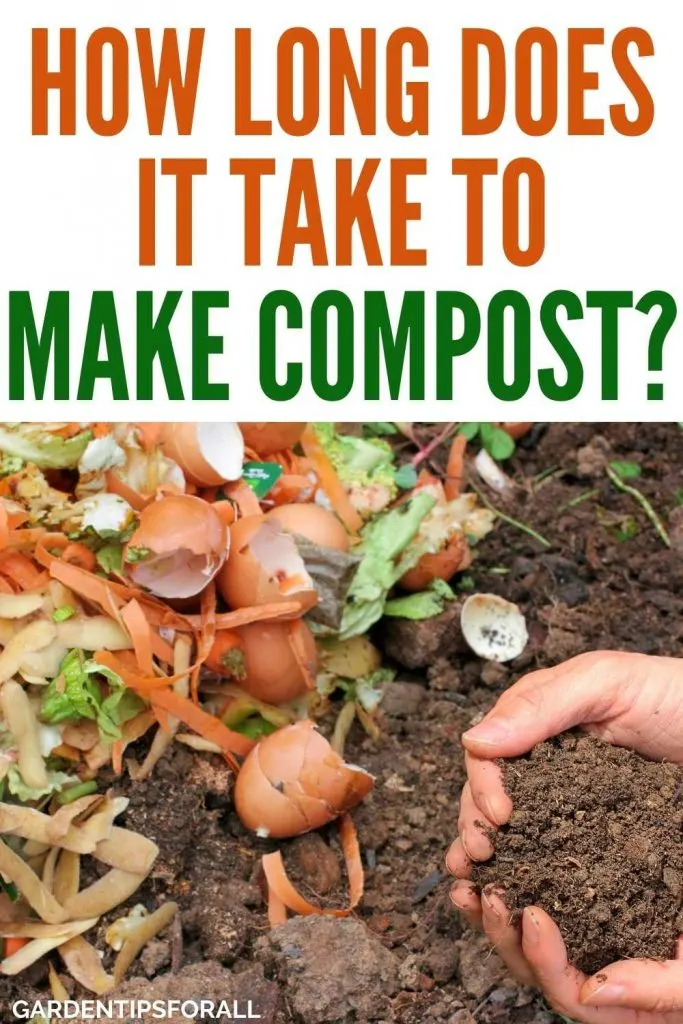How Long Does It Take To Make Compost?
Exactly how long does it take to make compost? This article provides the answer as well as tips on how to speed up the composting process and how to know when your compost is ready to be used.
If it’s your first time making compost, you are probably wondering how long it will take to have your compost ready.
The answer depends on the composting materials, size of the materials and size of the pile. Considering these factors, composting can take anywhere between 3 weeks to 3 years.

With the rising interest in growing food organically, compost has become a must-have because of its benefits compared to chemical fertilizer.
It often has balanced amounts of nutrients, is biodegradable, safe for plants, and helps keep our environment clean.
Many gardeners opt to make their compost to save on costs and maintain all-natural ingredients in the composition.
That’s because you can make compost with kitchen waste, animal manure, or any other organic material that’s readily available.
You may also want to read this article to get a detailed answer to the question, is manure and compost the same thing?
Factors that Influence Composting Duration
Below are some of the determining factors.
Size of the Bin
The size of the bin depends on your needs and the space available for placing it.
However, you should note that larger containers get and retain heat better than smaller ones.
But if you cannot change the bin’s size, place your small bin in an area that receives direct sunlight to quicken the composting process.
If you are using a larger bin, make sure it’s at least 3 feet high to ensure the materials heat up properly.
A plastic bin is better compared to a wooden one. That’s because plastic containers retain a lot of heat, which is necessary for composting. The wooden ones will absorb the moisture and begin to rot.
The Ingredients
Different materials break down at different rates when composting. For better compost, you have to balance between “green” and “brown” materials.
Green materials release nitrogen, while brown materials release carbon. Both components are essential for composting. The most preferred ratio of carbon to nitrogen is 20:1
With that in mind, the best green materials for composting include:
- Fruit scraps and leafy vegetable waste
- organic manure
- Grass clippings
- Cornstalk
- Seaweed
- Leaves and roots of the weeds
- Coffee grinds, tea bags, and old wines
- Eggshell
- Herbs
Brown materials include:
- Dead leaves
- Branches
- Twigs
- Pine needles
- Paper
- Cardboards
The size and shape of the materials also matter. Smaller materials compost faster than larger ones.
You can use a leaf shredder or lawnmower to cut the fallen leaves into smaller pieces.
And you can chop the kitchen scraps into smaller pieces using a knife. Better still, you can even blend the kitchen scraps.
Lastly, avoid adding too much material in a single bin. Preferably, you should use two containers if you have a lot of material for compost.
Temperature
When the inside of the bin is warmer than the surrounding, the bacteria work better in breaking down the compost.
It would help if you used a thermometer to check the temperature of your bin continually.
If you notice the temperature going down, it is the right time to turn the pile. However, if, after turning, it still feels cool, your compost is almost ready.
For effective composting, the temperatures should be between 40 to 60 Degrees Celsius (104 to 140 Degrees F). The outside temperatures should be between 40 Degrees F and 80 degrees F.
That’s why you should start preparing your compost pile during spring to take advantage of summer’s hot temperatures.
As mentioned earlier, plastic bins are the best for maintaining optimum heat for composting.
During the winter, you can add sawdust, straw, or shredded cardboard to prevent heat loss. You can also take the bin inside in winter.
Oxygen Flow
Oxygen is essential since it facilitates aerobic breakdown, which is faster and more efficient than the anaerobic process.
How and when to turn your compost is debatable. However, it would help to turn your pile weekly to facilitate air circulation.
If this is impossible, dig out a shaft from top to bottom. That way, air will still flow.
You can also crunch the paper and cardboards instead of using them flat, thus creating air pores within the compost.
Be careful not to allow excess oxygen flow as it will cause the compost to dry out. So keep checking the level of moisture, too.
Moisture
Moisture is another essential factor in composting. The microorganisms facilitating the breakdown process need water, and it also helps transport nutrients to microbes within the pile.
Most organic materials have some moisture, and if your pile is outdoors, it may get some water from rain.
But you can also water the pile occasionally. However, be careful not to add too little or too much. Your compost should appear and feel like a wet sponge and not soggy.
How Can I Speed Up My Compost Making Process?

Below are some ways to speed up the composting process.
Hot-Turn
This process involves turning the pile frequently, which will help get your compost ready within 3 weeks.
First of all, make sure you’re working with tiny particles and that you have the 20:1 carbon/nitrogen ratio (30:1 would also work), and the pile should be at least 3 feet tall. Rotate the pile daily for the first week. And then turn it over and over daily for the rest of the time.
Add Maggots or Black Soldier Flies
Maggots may seem gross, but they can speed up the composting process. They feed on the materials, breaking them down faster than bacteria.
They also can survive in hot temperatures, and they are useful in breaking down milk and meat products. The next time you see maggots in your pile, don’t get rid of them. Maggots can help get your compost ready in 1-3 months.
On the other hand, with black soldiers flies, your compost can be ready for use in 3 weeks.
What Should You Avoid Adding to Your Compost?
As much as you can’t wait to make compost, there are certain things you should not use in composting.
- Cooked foods – Cooked foods lead to wet and unusable mulch. When cooked food decays, it has an unpleasant smell that may attract fruit flies and other pests that you wouldn’t want around your home.
- Avoid using meat, dairy products, and stone fruits in your compost pile since they take longer to break down, leading to unbalanced compost.
- Avoid adding glass, plastics, metals, pet droppings, dead or diseased plants, and coal ash.
- If you’ve used chemical pesticides on your farm, avoid using them in your compost.
How Do You Know When Compost is Ready?

You can tell if compost is ready by looking at it and feeling it with your hands. Ready compost crumbles like real soil and looks like dark-brown rich earth.
For a more accurate result, you can test the temperature and pH levels of the compost.
Ready compost should have a pH level ranging from 6 to 8. It also feels cool, and the temperature levels are usually around 20 Degrees Celsius.
Always make sure you only use mature compost. Unready/immature compost still has pathogens and acids that will be harmful to your soil and plant.
Since immature compost needs nitrogen and oxygen to finish the process, it will draw out these nutrients from your soil and plants, hence damaging them.
Other Composting Techniques
There are other different methods of composting. Let’s briefly review some of them.
Onsite Composting
This method involves composting the materials in their original “ecological” setting.
For instance, instead of collecting grass clippings after mowing, you can leave them on the lawn. They will decompose and become natural fertilizer to the grass.
After pruning leaves, you can leave them as mulch around the trees. You can also let small amounts of food leftovers decompose. It’s easy to do, doesn’t require any special equipment, and is not subject to climate changes.
However, this method is not suitable for large quantities of food scraps or animal waste.
Vermicomposting

Vermicomposting involves adding worms like earthworms and red worms to break down the pile ingredients. The worms feed on the materials and excrete a ready compost.
So, if you have a large pile, you will need many worms to feed on the materials. For instance, 2000 worms can feed on 1 pound of compost in a day.
Usually, it will take three months to get the compost ready with an average number of worms.
There are several worm bins for sale that allow you to make compost indoors, even when you live in a congested apartment.
The worms also produce worm tea, which is also an excellent organic fertilizer.
Turned/Aerated Windrow Composting
This process involves large piles of compost arranged in “windrows” and turned/aerated frequently.
This process is mainly used in areas where compost is needed in large quantities. The piles range from 4 feet to 16 feet tall.
These piles are large enough to maintain the ideal temperatures, generate heat, and allow aeration.
You can compost any material in such a setting – from animal waste, food scraps to lawn clippings.
It’s a huge industrial process that needs to be regulated, and sometimes it releases a liquid that could pollute the environment.
A slightly similar method is the Aerated Static Composting. But, instead of turning it regularly, you use wood chips, shredded paper, or other bulking materials to allow air flow within the pile. You can also use pipes to deliver air inside the compost.
Direct Composting

Direct composting is the most common method where you dig a hole in your backyard and add the food scraps, kitchen waste, and all other ingredients in a pile.
Instead of digging a hole, you can also set up a simple structure or purchase tumblers. Composting in all these settings is similar, where you add the ingredients and turn occasionally.
EMO Composting
EMO (Effective Microorganisms) involves filling a bin with food scraps and other ingredients.
Once it’s full, seal it, and allow the material to break down. You can also purchase two systems and have a continuous supply of compost for your kitchen garden.
Slow No-Turn
This is the easiest but most prolonged method, which can take up to a year. It involves adding materials and waste into a pile in your yard gradually. However, the duration can vary, depending on the ingredients, temperature, and moisture levels.
Conclusion
Make a habit of always composting the organic waste in your home. Apart from enriching your garden with appropriate nutrients, you will also be conserving the environment by reducing waste. It may take months, or even years to compost, depending on the size and technique, but it’s worth the wait.

